A rush of events has propelled the Air Force into a new phase of the war on terrorism. The struggle in Iraq appears to be shifting course. At the same time, the fight in Afghanistan has begun escalating. Each of these developments is creating difficult new situations for airmen.
In both Southwest Asian nations, much hard work lies ahead, said some of the many USAF senior leaders who gathered at the Air Force Association’s 2009 Air Warfare Symposium, held in Orlando, Fla., in late February.
President Obama has ordered a buildup of forces in Afghanistan, including a big infusion of personnel and equipment as well as new infrastructure.
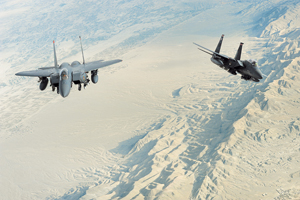 |
Two F-15Es carry out a mission over Afghanistan |
“We are obviously … in a growth period” in Afghanistan, said Lt. Gen. Gary L. North, who is US Central Command’s combined force air component commander. “So, for the next two or three years, this increase will define our US Air Force requirements.”
Statistics gathered by US Air Forces Central (AFCENT) show that, of 28,000 airmen currently deployed to the Central Command area of responsibility, 5,000 are based in Afghanistan—and an estimated 1,500 more are expected to arrive in conjunction with the new force expansion.
The Afghanistan buildup will affect the rest of the expeditionary Air Force as well, as units in both the Pacific and Europe are tied closely to deployments in and out of Southwest Asia.
“We feed the fight,” said Gen. Roger A. Brady, commander of US Air Forces in Europe. “We have, of our eight … fighter squadrons in Europe, … at least two of them downrange at any one time.”
For 250 days in 2008, USAFE had at least one fighter squadron (and usually two) deployed to the CENTCOM region. Several bases in Europe, including Ramstein AB, Germany, and Lajes Field in the Portuguese Azores are critical hubs to the mobility network connecting forces in Southwest Asia to the US.
As a good portion of USAFE forces are already in the mix in Iraq and Afghanistan, a challenge remains in fleshing out other emerging missions at the same time. For example, Brady said Ramstein-based 17th Air Force, US Africa Command’s air component, is finding it difficult getting the right rated expertise in place.
Four C-130 aircraft are currently assigned to the numbered air force, which “probably doesn’t do it for the continent of Africa,” he said.
For now, 17th Air Force is getting the forces it needs from other commands. For all its importance, Africa is not at the top of the priority queue, however.
Afghanistan, Air Force leaders said, is where American combat power is now being focused. Last year, close air support sorties in Afghanistan surpassed those in Iraq for the first time since at least 2003, according to AFCENT statistics.
Sortie requirements have exploded 170 percent, and requests for weapons delivery (usually for close air support) have nearly doubled between 2006 and 2008.
Due to its size—more than 251,700 square miles of mountains, deserts, and valleys—intelligence-surveillance-reconnaissance capabilities have proved to be the critical capabilities in Afghanistan for a range of operations. Ground force commanders will routinely “go out and hook up with the people flying our Predators, and they will walk through the details of how they want to conduct activities on a target,” said Lt. Gen. Donald C. Wurster, commander of Air Force Special Operations Command.
Predators and Reapers allow commanders to destroy a target, label objectives, and decide what needs to be ignored or watched. Fully a third of AFSOC’s UAV processing, exploitation, and dissemination activities are pushed forward—working directly with the in-country battlefield commanders—so airmen understand the battle rhythm, how the troops on the ground think, and what they want. When the airmen return to the States, he said, they have a unique perspective about how their mission fits into the whole operation.
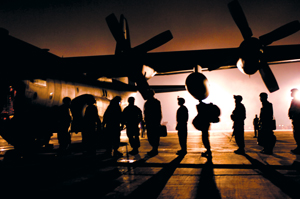 |
Soldiers line up to board a C-130H Hercules at Bagram Airfield, Afghanistan. (USAF photo by SSgt. Rachel Martinez) |
Project Liberty
The demands for full-motion video and other sensors have spurred the Air Force to deploy the MC-12 this spring. The MC-12 is the product of Project Liberty—the effort to meet the soaring ISR requirements with an easily deployable, off-the-shelf aircraft. Twin-engine King Air 350 aircraft will be loaded with sensors to meet some of the requirements for ISR which will likely increase with the force buildup in Afghanistan. The manned MC-12s will also be able to operate in high wind and during icing conditions—something Predators and Reapers cannot do, North said.
All fighters, bombers, and UAVs operated by the Air Force in theater now have the ability to “stare” and perform ISR missions with a targeting pod or an infrared or electro-optical sensor. Each of these aircraft has the capability to downlink data, and the ability to distribute information down to individuals in the field—a joint terminal attack controller or special operator—who can see exactly what a pilot or sensor operator is seeing overhead.
AFCENT planners are looking to shift Predator and Reaper capabilities from Iraq to Afghanistan over the coming months. The improved security situation in Iraq has allowed the Air Force to shift resources to Afghanistan.
To assist with the troop buildup, more tactical airlift such as C-130s will also be sent into Afghanistan. Airlift and air infrastructure will be critical to the buildup, Air Mobility Command’s Gen. Arthur J. Lichte noted.
Supplying fuel will be difficult in Afghanistan, Lichte said. Equipment can be moved in easily enough, but the ability to sustain operations hinges on having fuel available where aircraft and vehicles are based.
AMC wants to reduce the time and improve the velocity of its mobility efforts for Afghanistan, Lichte added.
Strategic airlifters such as USAF’s C-17s are already moving new Mine-Resistant Ambush-Protected vehicles directly into Afghanistan to get them to the troops who need them as quickly as possible. More MRAPs will be delivered by sea.
Mobility aircraft had already brought 600 relocatable buildings—just a first batch—as of late February, Lichte added. AMC is “moving forward, trying to improve every one of the locations that we operate at or through in Afghanistan,” he said.
Because of these kinds of world-spanning operations, the service views acquisition of a replacement tanker as its highest priority. Lichte said AMC has scrubbed down the putative 800 requirements in the tanker project to a figure that is “an order of magnitude” smaller, in hopes that less complexity will make the project easier to bid on and easier to award.
Lichte reaffirmed that the Air Force opposes buying two models of tankers for the aerial refueling mission.
The Solomonic solution suggested by many on Capitol Hill is to split the tanker buy between Boeing and Northrop Grumman-led proposals, but Lichte said the two-aircraft approach is manageable if Congress insists—and provides the extra money it would require.
Time is running out on the KC-135, however, Lichte said. Citing a 2001 KC-135 Economic Service Life Study which has proved remarkably accurate in predicting the challenges in keeping the old tanker flying, Lichte projected that AMC will likely have to start “re-skinning” the fleet within seven years. This requires an extremely expensive remanufacturing process that will sharply increase the usual $7 million cost to put a KC-135 through depot—but it won’t buy the type any additional capability.
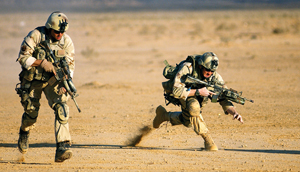 |
Combat controllers train for clandestine, covert, or low-visibility missions in the Afghanistan desert. |
USAF must also focus on operations targeting threats before they mature—so-called “Phase Zero” operations. “Imagine if, five years before [9/11], we knew that enemy terrorists working from some ungoverned sanctuary intended to strike the United States in the manner in which they did,” Wurster said.
“The question then is, for the next five years, what would the Air Force do about it?” A little bit of American influence matters a whole lot if it’s in the right place at the right time, he said.
Across the Pacific, this approach has worked wonders, said Gen. Carrol H. Chandler, commander of Pacific Air Forces. “We’re in Phase Zero every day in the Pacific Theater. You simply cannot surge engagement.”
As an example, he pointed to the success of the C-17 in humanitarian operations across the Pacific.
Revolutionary Capabilities
“The C-17 has paid huge dividends for us,” said Chandler, noting that he had sent the airlifters to China twice in 2008—once during fierce snowstorms in February and again after the Sichuan earthquake in May.
“We’ve had two Chinese general officers, one a ground force fellow and the other an airman, into our headquarters, and they will tell you that they will never forget what the United States did for them in terms of humanitarian assistance and disaster relief,” Chandler said.
“The second statement or question they ask is, and how did you do that so quickly? Which is something I don’t mind them puzzling about, quite frankly,” he added. The Air Force’s demonstrated responsiveness causes China to “think a little bit about how they do business.”
The Air Force is showing its responsiveness daily in Iraq and Afghanistan, and from counterinsurgency operations to close air support, today’s combat Air Force is being retooled and reshaped almost in real time, said Dr. Rebecca Grant, a senior fellow at the Lexington Institute as well as director of the Mitchell Institute in Washington, D.C. Grant’s special report for the Mitchell Institute, “Airpower in Afghanistan,” was released during the symposium.
“A lot of the innovation that is so close to the core of what the Air Force does is taking place in Afghanistan,” she said.
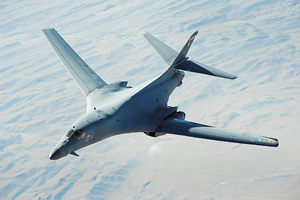 |
A USAF B-1B from the 34th Expeditionary Squadron patrols the sky over Afghanistan. |
A host of revolutionary capabilities have been tested there just in the last few years—from the development of the Joint Precision Airdrop System, the use of Remotely Operated Video Enhanced Receiver (ROVER) technology in calling in close air support, or the veritable explosion of ISR needs—particularly for full-motion video assets such as the Predator and Reaper. “There seem to be changes month to month, week to week,” Grant added.
The Air Force is already moving, along with the other services, to prepare the battlefield for the expanding mission in Afghanistan, North said. AFCENT planners are building up some of the in-country aerial port facilities, such as the large hubs at Bagram Air Base and Kandahar Airfield, and are moving USAF civil engineers from Iraq to Afghanistan to prepare for the influx of US troops.
“As we look at where these forces will be deployed to employ, they’ve got to have infrastructure,” he said. This includes not just air infrastructure, but secure overland routes from the north and south of Afghanistan. “Having multiple lines of approach as we discuss the buildup is very important,” North added.
Complicating the buildup is the looming loss of Manas Air Base in Kyrgyzstan, a major refueling hub and the primary through-point for troops headed into Afghanistan. CENTCOM is looking at a “variety of options” for redeploying the airlift and tanker capabilities based there, should the US lose access to the facility. “We’ve got until August to figure this out,” North said.
The mission is not all about air-breathers, however. “We start with those whirling satellites overhead, one of which times the entire world these days and that’s our GPS satellites,” North said of space capabilities. Space dominance gives the Air Force the precision, surveillance, and communication capabilities vital to the fight in both Iraq and Afghanistan.
Gen. C. Robert Kehler, head of Air Force Space Command, emphasized the need for space situational awareness. This was brought back to the forefront after a February collision in orbit between a deactivated Russian satellite and an active commercial communications satellite. The unexpected smashup in space created a wide debris field in orbit.
Inadequate space situational awareness is troubling because many space-based capabilities are perilously thin. Gen. Kevin P. Chilton, commander of US Strategic Command, said he’s unhappy about the fact that the nation has grown accustomed to “the mind-set of just-in-time resupply of critical on-orbit constellations” of early warning and communication systems.
“We have almost gotten to the point where we are counting on … 100 percent launch success,” a standard that is probably impossible to sustain. If even one launch fails, there would be “a critical gap in what this nation needs” for warning, surveillance, or communications, Chilton warned.
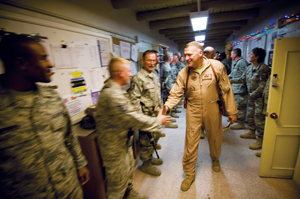 |
A USAF B-1B from the 34th Expeditionary Squadron patrols the sky over Afghanistan. |
An Unpredictable Threat
There’s some redundancy in on-orbit capability, he said, but the issue must be considered now, because “managing to a gap is not the way to go … having the ability to [endure] a launch failure is something that we should very much consider as we look to the future.”
Kehler mentioned another priority that was prominent with several top officials—the stand-up of the Air Force’s cyber warfare mission through AFSPC’s 24th Air Force.
The cyber domain is the new frontier in irregular warfare, and the US had better get up to speed on it, Kehler said. “We are going to have to counter irregular warfare tactics in space and cyberspace,” he said.
The threat is unpredictable, constantly changing, and the enemy could be across the street or around the world. The United States has “got to get better at cyber defense,” he said, and the creation of a numbered air force for cyber operations gives the mission a combat mentality.
“I tell our people, when you come to work, … you are entering a combat zone, and everyone has to be a defender,” Kehler said. “We don’t have a security forces squadron for cyberspace.”
Despite heightened awareness of the importance of cyber security, the necessary cultural change to go with it hasn’t appeared yet, Chilton said.
“In the cyberspace domain, here are some obvious things: We are under attack. We are behind. We are reactive; we are not proactive. And we, all of us, are making it too easy—too easy—for those who would exploit and attack our networks today.”
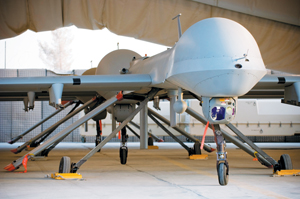 |
Three MQ-1 Predator UAVs are ready for launch in a hangar at a base in southern Afghanistan. |
Commanders should know their cyber status and devote the same attention to it as to mission capable rates or other “metrics that we look at for logistics and maintenance of our aircraft,” Chilton said. “Commanders should demand reviews of the health and status of their networks.” Without functional, reliable networks, he said, the force will be hamstrung.” This is a cultural shift we need to make—all of us.”
The lowest point of entry is all it takes to compromise a network, Chilton noted. He also said that despite the distributed nature of networks, there needs to be “centralized command and control” of cyber defenses. A central C2 needs to be able to look across the network and be aware of defenses at every level, he said.
US Northern Command and North American Aerospace Defense Command know the danger. Gen. Victor E. Renuart, NORTHCOM and NORAD commander, said hackers broke into both his commands’ secure networks in 2008.
The cyberspace threat is indicative of the changing nature of the homeland defense mission, Renuart noted. “One of the challenges we face in our binational command of NORAD is that we’ve expanded our mission set from [the traditional] air domain that we lived in [as] the very first of our missions 50 years ago.”
NORAD must get data and information to national decision-makers of two countries—which makes countering the cyber threat critical.
The Air Force is looking at Air Guardsmen and Reservists who work for private technology companies as likely cyber experts, said Lt. Gen. Harry M. Wyatt III, director of the Air National Guard.